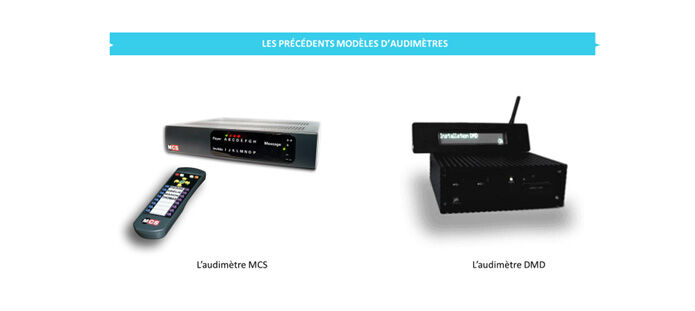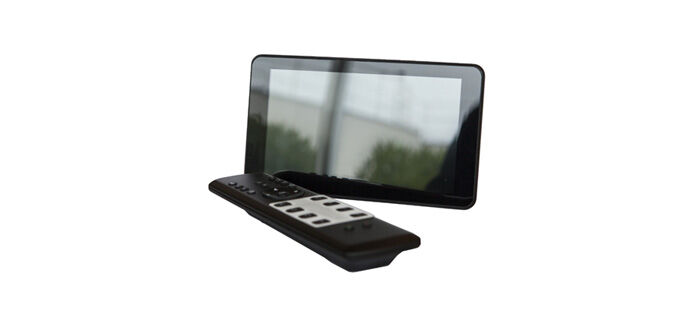New meter : technological innovation serving TV audience measurement
Developed by Médiamétrie’s R&D teams, it has a touchscreen, requires much less cabling, and streamlines interactions with panellists. A look at the origins of an innovation that’s driving progress in audience measurement.
Television audience measurement in France involves 5,000 households (more than 11,500 individuals) equipped with a box (the people meter) that identifies the TV programmes watched on the television set by any member of the panellist household or its guests, be it live, time-shifted on a recording, or on catch-up. Each television set in the household is equipped with a people meter. That means there are a total of 7,750 boxes on metropolitan French territory. They transmit measurement data on a regular basis throughout the day, allowing Médiamétrie to supply television channels with the Médiamat from 9:00 am: the audience ratings for programmes watched live or time-shifted the day before.
A new audience meter that’s in tune with the times
Audiovisual equipment and television consumption methods are changing. At the same time, technology is improving. Jérôme Méric, Director of Measurement Systems Development at Médiamétrie, is continuously asking himself the following question:“what is the best technical platform we can use to capture television uses in an increasingly effective way?”. People meters have already seen several changes in the 28 years they have been used for audience measurement.

The TVM3 is therefore the latest generation. To answer this question, the teams at Médiamétrie very quickly had the idea of taking inspiration from a tablet: smaller in size (7 inches), a strong community of developers, cutting-edge in terms of technology, easier to install, and more ergonomic for the panellist. According to Jérôme Méric, “technological evolutions lead to the integration of features that we can benefit from”.
The TVM3 people meter

A Médiamétrie development
After their initial idea of drawing inspiration from the tablet, the teams at Médiamétrie took two years to develop the TVM3 people meter. The first year involved an exploratory phase to test the feasibility and appropriateness of the concept, and in the second year the device was put into production. Some ten Médiamétrie engineers applied their technological expertise and know-how in audience measurement to develop the TVM3.
Damien Durand, technical project manager in charge of developing this new people meter, explains that “the tablet base had to be heavily adapted to audience measurement needs”: it had to stand up horizontally by itself, include audience measurement technology (watermarking1 and fingerprinting2), and be able to send the data to Médiamétrie’s servers.
The TVM3 has therefore been completely “revamped”: it has a specific power supply system, a more powerful speaker for the reminder signals emitted to the panellists, and a wall-mount system in case the television set is fixed to the wall. Even the remote control, which allows the panellist to identify him- or herself, has been totally rethought to meet current standards, and is now equipped with Bluetooth technology. Although the TVM3 is manufactured by an external company, all the software was developed internally.
Médiamétrie’s teams also developed an interface for managing the people meter stock: this tool makes it possible to view the activity and performance of the people meters in real time, in order to detect any malfunctions, launch updates and send messages to the panellists.
Ergonomic and simple
This new device has multiple advantages in addition to its smaller size; specifically, it is much quicker to install in panellist households. This means that Médiamétrie’s audiovisual technicians, who set up the people meters, have more time to talk to the panellists about good practices in audience measurement.
The regular interactions between Médiamétrie and the panellists are made much simpler: the panellist can find useful information on the people meter, enter holiday dates directly on the device, and receive messages on it from Médiamétrie.
Finally, the TVM3 is equipped with a battery that enables it to keep working in the event of a power cut. This ensures that audience data can be collected on a daily basis.
A gradual roll-out
Renewing a stock of people meters distributed across the entire metropolitan French territory is a gargantuan task! The first TVM3s are currently being installed in the Médiamat panel: almost 100 have already been set up and 5000 will be in place by the end of 2019.
1 Watermarking consists of inserting an audio tag that is inaudible to the human ear into the programmes of television channels. This tag, known as a watermark, identifies the channel broadcasting the tagged programme as well as regular markers of the broadcast time. People meters installed in panellist households detect and record these signals.
2 “Fingerprinting” consists in extracting a “sample” of audiovisual content watched or listened to on an audiovisual platform or on the Internet. It is then compared with a complete database of the programmes on a channel or in a programme catalogue. If this “sample” turns out to belong to this database, then it comes from that channel or catalogue.
TVM3 in Morocco
Morocco was where the TVM3 first launched in real conditions. The company Marocmétrie, a subsidiary of Médiamétrie and LMS/CSA, has been measuring television audiences in Morocco since 2008 on behalf of the CIAUMED* and the device had already been piloted for the use of watermarking from 2007. Ten years later, from July 2017, the 1,000 Moroccan panellist households gradually introduced the new TVM3 people meters, and today, all the households have one.
Since April 2018, fingerprinting has also been launched in Morocco in order to increase the number of channels measured.
* The Economic Interest Group in charge of audience measurement
Laure Osmanian Molinero
des médias
edition
definitions